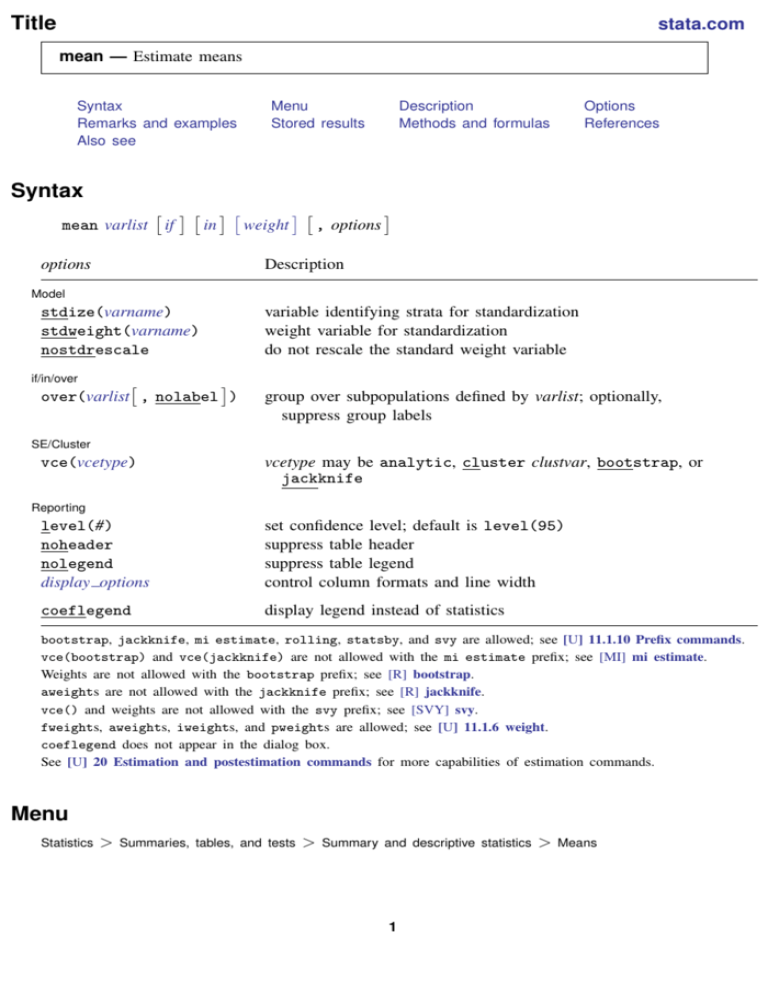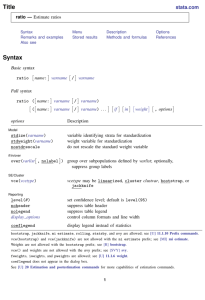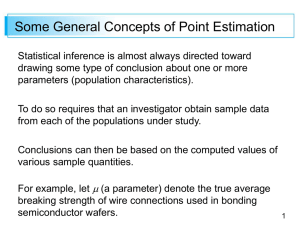Estimate means
advertisement

Title stata.com mean — Estimate means Syntax Remarks and examples Also see Menu Stored results Description Methods and formulas Options References Syntax mean varlist if in weight , options Description options Model stdize(varname) stdweight(varname) nostdrescale variable identifying strata for standardization weight variable for standardization do not rescale the standard weight variable if/in/over over(varlist , nolabel ) group over subpopulations defined by varlist; optionally, suppress group labels SE/Cluster vce(vcetype) vcetype may be analytic, cluster clustvar, bootstrap, or jackknife Reporting level(#) noheader nolegend display options set confidence level; default is level(95) suppress table header suppress table legend control column formats and line width coeflegend display legend instead of statistics bootstrap, jackknife, mi estimate, rolling, statsby, and svy are allowed; see [U] 11.1.10 Prefix commands. vce(bootstrap) and vce(jackknife) are not allowed with the mi estimate prefix; see [MI] mi estimate. Weights are not allowed with the bootstrap prefix; see [R] bootstrap. aweights are not allowed with the jackknife prefix; see [R] jackknife. vce() and weights are not allowed with the svy prefix; see [SVY] svy. fweights, aweights, iweights, and pweights are allowed; see [U] 11.1.6 weight. coeflegend does not appear in the dialog box. See [U] 20 Estimation and postestimation commands for more capabilities of estimation commands. Menu Statistics > Summaries, tables, and tests > Summary and descriptive statistics 1 > Means 2 mean — Estimate means Description mean produces estimates of means, along with standard errors. Options Model stdize(varname) specifies that the point estimates be adjusted by direct standardization across the strata identified by varname. This option requires the stdweight() option. stdweight(varname) specifies the weight variable associated with the standard strata identified in the stdize() option. The standardization weights must be constant within the standard strata. nostdrescale prevents the standardization weights from being rescaled within the over() groups. This option requires stdize() but is ignored if the over() option is not specified. if/in/over over(varlist , nolabel ) specifies that estimates be computed for multiple subpopulations, which are identified by the different values of the variables in varlist. When this option is supplied with one variable name, such as over(varname), the value labels of varname are used to identify the subpopulations. If varname does not have labeled values (or there are unlabeled values), the values themselves are used, provided that they are nonnegative integers. Noninteger values, negative values, and labels that are not valid Stata names are substituted with a default identifier. When over() is supplied with multiple variable names, each subpopulation is assigned a unique default identifier. nolabel requests that value labels attached to the variables identifying the subpopulations be ignored. SE/Cluster vce(vcetype) specifies the type of standard error reported, which includes types that are derived from asymptotic theory (analytic), that allow for intragroup correlation (cluster clustvar), and that use bootstrap or jackknife methods (bootstrap, jackknife); see [R] vce option. vce(analytic), the default, uses the analytically derived variance estimator associated with the sample mean. Reporting level(#); see [R] estimation options. noheader prevents the table header from being displayed. This option implies nolegend. nolegend prevents the table legend identifying the subpopulations from being displayed. display options: cformat(% fmt) and nolstretch; see [R] estimation options. The following option is available with mean but is not shown in the dialog box: coeflegend; see [R] estimation options. mean — Estimate means Remarks and examples 3 stata.com Example 1 Using the fuel data from example 3 of [R] ttest, we estimate the average mileage of the cars without the fuel treatment (mpg1) and those with the fuel treatment (mpg2). . use http://www.stata-press.com/data/r13/fuel . mean mpg1 mpg2 Mean estimation Number of obs mpg1 mpg2 = 12 Mean Std. Err. [95% Conf. Interval] 21 22.75 .7881701 .9384465 19.26525 20.68449 22.73475 24.81551 Using these results, we can test the equality of the mileage between the two groups of cars. . test mpg1 = mpg2 ( 1) mpg1 - mpg2 = 0 F( 1, 11) = Prob > F = 5.04 0.0463 Example 2 In example 1, the joint observations of mpg1 and mpg2 were used to estimate a covariance between their means. . matrix list e(V) symmetric e(V)[2,2] mpg1 mpg2 mpg1 .62121212 mpg2 .4469697 .88068182 If the data were organized this way out of convenience but the two variables represent independent samples of cars (coincidentally of the same sample size), we should reshape the data and use the over() option to ensure that the covariance between the means is zero. . use http://www.stata-press.com/data/r13/fuel . stack mpg1 mpg2, into(mpg) clear . mean mpg, over(_stack) Mean estimation 1: _stack = 1 2: _stack = 2 Number of obs = 24 Over Mean Std. Err. [95% Conf. Interval] 1 2 21 22.75 .7881701 .9384465 19.36955 20.80868 mpg 22.63045 24.69132 4 mean — Estimate means . matrix list e(V) symmetric e(V)[2,2] mpg: mpg: 1 2 mpg:1 .62121212 mpg:2 0 .88068182 Now we can test the equality of the mileage between the two independent groups of cars. . test [mpg]1 = [mpg]2 ( 1) [mpg]1 - [mpg]2 = 0 F( 1, 23) = 2.04 Prob > F = 0.1667 Example 3: standardized means Suppose that we collected the blood pressure data from example 2 of [R] dstdize, and we wish to obtain standardized high blood pressure rates for each city in 1990 and 1992, using, as the standard, the age, sex, and race distribution of the four cities and two years combined. Our rate is really the mean of a variable that indicates whether a sampled individual has high blood pressure. First, we generate the strata and weight variables from our standard distribution, and then use mean to compute the rates. . use http://www.stata-press.com/data/r13/hbp, clear . egen strata = group(age race sex) if inlist(year, 1990, 1992) (675 missing values generated) . by strata, sort: gen stdw = _N . mean hbp, over(city year) stdize(strata) stdweight(stdw) Mean estimation N. of std strata = 24 Number of obs = 455 Over: city year _subpop_1: 1 1990 _subpop_2: 1 1992 _subpop_3: 2 1990 _subpop_4: 2 1992 _subpop_5: 3 1990 _subpop_6: 3 1992 _subpop_7: 5 1990 _subpop_8: 5 1992 Over Mean hbp _subpop_1 _subpop_2 _subpop_3 _subpop_4 _subpop_5 _subpop_6 _subpop_7 _subpop_8 .058642 .0117647 .0488722 .014574 .1011211 .0810577 .0277778 .0548926 Std. Err. .0296273 .0113187 .0238958 .007342 .0268566 .0227021 .0155121 0 [95% Conf. Interval] .0004182 -.0104789 .0019121 .0001455 .0483425 .0364435 -.0027066 . .1168657 .0340083 .0958322 .0290025 .1538998 .1256719 .0582622 . The standard error of the high blood pressure rate estimate is missing for city 5 in 1992 because there was only one individual with high blood pressure; that individual was the only person observed in the stratum of white males 30–35 years old. mean — Estimate means 5 By default, mean rescales the standard weights within the over() groups. In the following, we use the nostdrescale option to prevent this, thus reproducing the results in [R] dstdize. . mean hbp, over(city year) nolegend stdize(strata) stdweight(stdw) > nostdrescale Mean estimation N. of std strata = 24 Number of obs = 455 Over Mean hbp _subpop_1 _subpop_2 _subpop_3 _subpop_4 _subpop_5 _subpop_6 _subpop_7 _subpop_8 .0073302 .0015432 .0078814 .0025077 .0155271 .0081308 .0039223 .0088735 Std. Err. .0037034 .0014847 .0038536 .0012633 .0041238 .0022772 .0021904 0 [95% Conf. Interval] .0000523 -.0013745 .0003084 .000025 .007423 .0036556 -.0003822 . Video example Descriptive statistics in Stata Stored results mean stores the following in e(): Scalars e(N) e(N over) e(N stdize) e(N clust) e(k eq) e(df r) e(rank) Macros e(cmd) e(cmdline) e(varlist) e(stdize) e(stdweight) e(wtype) e(wexp) e(title) e(cluster) e(over) e(over labels) e(over namelist) e(vce) e(vcetype) e(properties) e(estat cmd) e(marginsnotok) number of observations number of subpopulations number of standard strata number of clusters number of equations in e(b) sample degrees of freedom rank of e(V) mean command as typed varlist varname from stdize() varname from stdweight() weight type weight expression title in estimation output name of cluster variable varlist from over() labels from over() variables names from e(over labels) vcetype specified in vce() title used to label Std. Err. b V program used to implement estat predictions disallowed by margins .0146082 .004461 .0154544 .0049904 .0236312 .012606 .0082268 . 6 mean — Estimate means Matrices e(b) e(V) e( N) e( N stdsum) e( p stdize) e(error) Functions e(sample) vector of mean estimates (co)variance estimates vector of numbers of nonmissing observations number of nonmissing observations within the standard strata standardizing proportions error code corresponding to e(b) marks estimation sample Methods and formulas Methods and formulas are presented under the following headings: The mean estimator Survey data The survey mean estimator The standardized mean estimator The poststratified mean estimator The standardized poststratified mean estimator Subpopulation estimation The mean estimator Let y be the variable on which we want to calculate the mean and yj an individual observation on y , where j = 1, . . . , n and n is the sample size. Let wj be the weight, and if no weight is specified, define wj = 1 for all j . For aweights, the wj are normalized to sum to n. See The survey mean estimator for pweighted data. Let W be the sum of the weights W = n X wj j=1 The mean is defined as y= n 1 X wj yj W j=1 The default variance estimator for the mean is n Vb (y) = X 1 wj (yj − y)2 W (W − 1) j=1 The standard error of the mean is the square root of the variance. If x, xj , and x are similarly defined for another variable (observed jointly with y ), the covariance estimator between x and y is n d Cov(x, y) = X 1 wj (xj − x)(yj − y) W (W − 1) j=1 mean — Estimate means 7 Survey data See [SVY] variance estimation, [SVY] direct standardization, and [SVY] poststratification for discussions that provide background information for the following formulas. The following formulas are derived from the fact that the mean is a special case of the ratio estimator where the denominator variable is one, xj = 1; see [R] ratio. The survey mean estimator Let Yj be a survey item for the j th individual in the population, where j = 1, . . . , M and M is the size of the population. The associated population mean for the item of interest is Y = Y /M where M X Yj Y = j=1 Let yj be the survey item for the j th sampled individual from the population, where j = 1, . . . , m and m is the number of observations in the sample. c, where The estimator for the mean is y = Yb /M Yb = m X wj yj c= M and m X j=1 wj j=1 and wj is a sampling weight. The score variable for the mean estimator is zj (y) = cyj − Yb yj − y M = c c2 M M The standardized mean estimator Let Dg denote the set of sampled observations that belong to the g th standard stratum and define IDg (j) to indicate if the j th observation is a member of the g th standard stratum; where g = 1, . . . , LD and LD is the number of standard strata. Also, let πg denote the fraction of the population that belongs to the g th standard stratum, thus π1 + · · · + πLD = 1. πg is derived from the stdweight() option. The estimator for the standardized mean is yD = LD X πg g=1 where Ybg = m X IDg (j) wj yj Ybg cg M and j=1 cg = M m X j=1 The score variable for the standardized mean is zj (y D ) = LD X g=1 πg IDg (j) cg yj − Ybg M cg2 M IDg (j) wj 8 mean — Estimate means The poststratified mean estimator Let Pk denote the set of sampled observations that belong to poststratum k and define IPk (j) to indicate if the j th observation is a member of poststratum k ; where k = 1, . . . , LP and LP is the number of poststrata. Also let Mk denote the population size for poststratum k . Pk and Mk are identified by specifying the poststrata() and postweight() options on svyset; see [SVY] svyset. The estimator for the poststratified mean is yP = where Yb P = LP X Mk ck M k=1 and cP = M Yb P Yb P = cP M M LP m X Mk X Ybk = k=1 LP X Mk k=1 ck M LP X ck = M ck M IPk (j) wj yj j=1 Mk = M k=1 The score variable for the poststratified mean is LP Mk zj (Yb P ) 1 X IPk (j) zj (y ) = = ck M M M P k=1 Ybk yj − ck M ! The standardized poststratified mean estimator The estimator for the standardized poststratified mean is y DP = LD X YbgP cgP M πg g=1 where YbgP = Lp X Mk k=1 and cgP = M ck M Ybg,k = k=1 Lp X Mk k=1 Lp m X Mk X ck M cg,k = M ck M IDg (j)IPk (j) wj yj j=1 Lp m X Mk X k=1 ck M IDg (j)IPk (j) wj j=1 The score variable for the standardized poststratified mean is zj (y DP ) = LD X g=1 where zj (YbgP ) = LP X k=1 and cP ) zj ( M g = πg cgP zj (YbgP ) − YbgP zj (M cgP ) M cP )2 (M Mk IPk (j) ck M LP X k=1 g ( Mk IPk (j) ck M Ybg,k IDg (j)yj − ck M ( cg,k M IDg (j) − ck M ) ) mean — Estimate means 9 Subpopulation estimation Let S denote the set of sampled observations that belong to the subpopulation of interest, and define IS (j) to indicate if the j th observation falls within the subpopulation. cS , where The estimator for the subpopulation mean is y S = Yb S /M Yb S = m X IS (j) wj yj cS = M and j=1 m X IS (j) wj j=1 Its score variable is zj (y S ) = IS (j) cS yj − Yb S yj − y S M = IS (j) cS )2 cS (M M The estimator for the standardized subpopulation mean is y DS = LD X πg g=1 where YbgS = m X IDg (j)IS (j) wj yj YbgS cgS M cgS = M and j=1 m X IDg (j)IS (j) wj j=1 Its score variable is zj (y DS ) = LD X πg IDg (j)IS (j) g=1 cgS yj − YbgS M cgS )2 (M The estimator for the poststratified subpopulation mean is yP S = where Yb P S = LP X Mk k=1 and cP S = M ck M YbkS = k=1 LP m X Mk X k=1 LP X Mk ck M Yb P S cP S M ckS = M ck M IPk (j)IS (j) wj yj j=1 LP m X Mk X k=1 ck M IPk (j)IS (j) wj j=1 Its score variable is zj (y P S ) = where bPS zj ( Y )= cP S zj (Yb P S ) − Yb P S zj (M cP S ) M cP S )2 (M LP X k=1 Mk IPk (j) ck M ( Yb S IS (j) yj − k ck M ) 10 mean — Estimate means and cP S ) = zj (M LP X k=1 Mk IPk (j) ck M ( cS M IS (j) − k ck M ) The estimator for the standardized poststratified subpopulation mean is y DP S = LD X πg g=1 where YbgP S = Lp X Mk k=1 and cgP S = M ck M S Ybg,k = k=1 Lp m X Mk X k=1 Lp X Mk ck M YbgP S cgP S M S cg,k M = ck M IDg (j)IPk (j)IS (j) wj yj j=1 Lp m X Mk X k=1 ck M IDg (j)IPk (j)IS (j) wj j=1 Its score variable is zj (y DP S ) = LD X g=1 where zj (YbgP S ) = LP X k=1 and cgP S ) = zj (M πg cP S zj (Yb P S ) − Yb P S zj (M cP S ) M g g g g cgP S )2 (M Mk IPk (j) ck M LP X k=1 ( Mk IPk (j) ck M S Ybg,k IDg (j)IS (j) yj − ck M ( cS M g,k IDg (j)IS (j) − ck M ) ) References Bakker, A. 2003. The early history of average values and implications for education. Journal of Statistics Education 11(1). http://www.amstat.org/publications/jse/v11n1/bakker.html. Cochran, W. G. 1977. Sampling Techniques. 3rd ed. New York: Wiley. Stuart, A., and J. K. Ord. 1994. Kendall’s Advanced Theory of Statistics: Distribution Theory, Vol I. 6th ed. London: Arnold. mean — Estimate means Also see [R] mean postestimation — Postestimation tools for mean [R] ameans — Arithmetic, geometric, and harmonic means [R] proportion — Estimate proportions [R] ratio — Estimate ratios [R] summarize — Summary statistics [R] total — Estimate totals [MI] estimation — Estimation commands for use with mi estimate [SVY] direct standardization — Direct standardization of means, proportions, and ratios [SVY] poststratification — Poststratification for survey data [SVY] subpopulation estimation — Subpopulation estimation for survey data [SVY] svy estimation — Estimation commands for survey data [SVY] variance estimation — Variance estimation for survey data [U] 20 Estimation and postestimation commands 11









